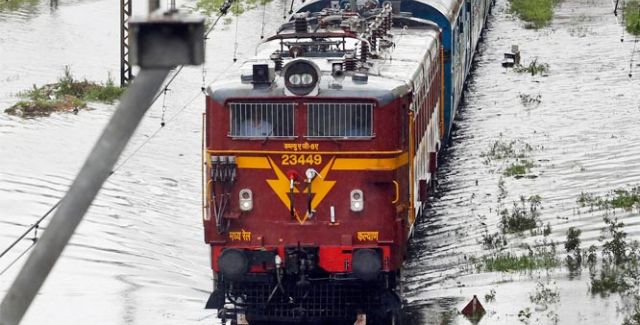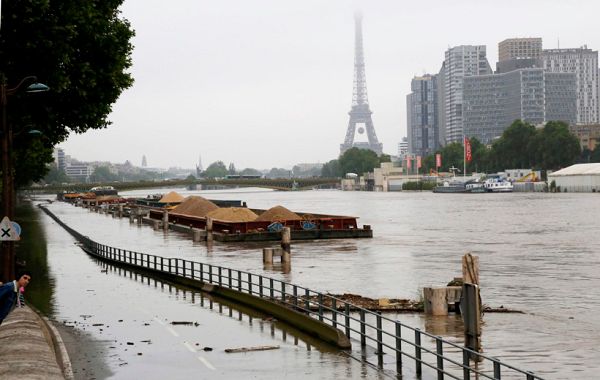
by admin | May 25, 2021 | News, Politics
 By Quaid Najmi,
By Quaid Najmi,
Mumbai : Torrential rains lashed Mumbai, Thane, Palghar, Raigad and other parts of Maharashtra for the fourth consecutive day on tuesday, severely affecting normal life and paralysing the lifelines — local train and bus services — in the state capital and leading the state government and civic authorities to sound a high alert.
Expressing concern over the rain situation in Mumbai, Prime Minister Narendra Modi urged the people of the state to “stay safe” and take all essential precautions while speaking to Chief Minister Devendra Fadnavis to take stock of the developments.
“The centre assures all possible support to the Maharashtra Government in mitigating the situation due to heavy rains in parts of the state,” Modi said in a series of tweets.
The BrihanMumbai Municipal Corporation (BMC) said that in one hour, Mumbai recorded a staggering 70 mm rainfall, while it touched 100 mm between 8.30 a.m. and 1 p.m.
Giving the figures till 3 p.m., the BMC said Mumbai received 106 mm rainfall in about six hours, while the eastern suburbs got 78.5 mm and the western suburbs notched 85 mm during the same period.
The state government has requisitioned the services of five disaster management teams, including three from Pune, and a holiday has been declared for all college and schools on Wednesday, said Education Minister Vinod Tawde.
The India Meteorological Department has forecast aceheavy to very heavy rains” for Mumbai and entire Konkan region during the next 24 hours owing to a “low pressure” area over south Gujarat-Madhya Pradesh, which was expected to be upgraded to a “deep depression”.
The BMC appealed to people not to step out of their home unless absolutely necessary, while the entire civic force — Mumbai Police, Fire Brigade and other agencies — were on high alert to combat the situation.
Since Tuesday morning, many parts of Mumbai and suburbs were inundated with up to three to four feet of water on the highways, main and arterial roads, bylanes, housing complexes, railway stations and even the Mumbai Airport.
However even with more than 180 trees and half a dozen walls collapsing in different parts of the city, flooding and waterlogging, there were no casualties.
Around 6.30 a.m. the rains triggered a landslide in adjoining Thane district, leading to derailment of 10 coaches of the Nagpur-Mumbai Duronto Express but there were no casualties.
The torrential rains have hit the immersion ceremonies on the fifth day of the Ganeshotsav on Tuesday, with many marquees deciding to postpone it by two days.
Suburban local trains were massively hit with disruption in services due to flooding on the railway tracks at several places.
The Central Railway mainline was completely suspended for over four hours, Harbour Line was completely down, the Western Railway worked slowly and erratically, besides disruptions on the Konkan Railway.
Lakhs of commuters including students, were stranded in trains, railway stations or at bus stops. Many failed to reach their destinations and were compelled to return to their homes on foot, walking scores of kilometres from various points in the city.
All the gurudwaras, several Hindu and Jain temples, Ganeshotsav marquees, mosques and dargahs, churches, NGOs, charitable organisations, housing complexes and individuals made arrangements to offer food and beverages to the weary and stranded commuters, and arrangements to rest for the night.
Waterlogging has been reported from Dahisar, Borivali, Kandivali, Malad, Andheri, Jogeshwari, Vile Parle, Santacruz, Bandra, Matunga, Dadar, Elphinstone, Mumbai Central, Mazagaon, Lalbaug, Parel, Sion, Wadala, Kurla, Bhandup and other areas.
The rains affected normal operations at Chhatrapati Shivaji Maharaj International Airport with flights getting delayed by around 35 minutes mainly on account of low visibility.
Seven incoming flights were made to go around till landing permission was granted while three flights were diverted, though operations continued.
Domestic and international passengers bound for the airport to catch their flights faced huge problems in reaching on time due to massive traffic snarls on the highways and main roads.
Mumbai IMD head K.S. Hosalikar said that in three hours since 8.30 a.m., Mumbai suburbs recorded a whopping 86 mm of rains, while Colaba recorded around 16 mm of rains.
“It’s not a July 26, 2005 type situation as the cloud cover over Mumbai is not that thick. However, we have issued weather warnings to the disaster units of Maharashtra government and the BrihanMumbai Municipal Corporation,” Hosalikar told media persons.
He said the IMD has forecast heavy to very heavy rains for at least the next 24 hours all over Maharashtra, especially over coastal North Konkan, Mumbai and other parts of the state.
The IMD warning says “intense precipitation likely to occur over Mumbai city, suburbs, Dahanu and Raigad during the latter part today (Tuesday)”.
In Mumbai areas which recorded the heaviest rains are: Matunga 253 mm, Parel 230 mm, Wadala 260mm, Bandra 210 mm, Vile Parle and Santacruz A212 mm, Worli -235, and Kurla 208 mm, said a BMC Disaster Control official.
(Quaid Najmi can be contacted at q.najmi@ians.in)
—IANS

by admin | May 25, 2021 | News
 By Sahana Ghosh,
By Sahana Ghosh,
Kolkata : As floods ravage India and its neighbours, experts at IIT-Kharagpur (IIT-Kgp) say states with high forest cover are more likely to better cope with the damage caused.
In a study published in the journal Land Use Policy in July, researchers from the institute examined the impact of forest cover on flood damage in terms of human lives lost and population affected from 1998 to 2011 across all Indian states except Telangana, which came into existance only in 2014.
“The study findings indicate that for a majority of states, the presence of forest cover tends to protect human lives and reduce the adverse consequences of floods significantly,” PhD scholar Kasturi Bhattacharjee of IIT-Kgp’s Department of Humanities and Social Sciences, told IANS.
According to the analysis, the average number of lives lost is quite high in Andhra Pradesh, Assam, Gujarat, Maharashtra, Uttar Pradesh and West Bengal.
The states which have recorded a high number of people affected by floods include Andhra Pradesh, Assam, Chhattisgarh, West Bengal and Uttarakhand.
Bhattacharjee said while for some states (such as West Bengal, Uttarakhand), the damage declined with increasing presence of forest cover during the study period, this did not apply to other states like Madhya Pradesh.
Madhya Pradesh, incidentally, is the state which has recorded the highest average forest cover at 76,294.07 sq. km. (24.75 per cent of its geographical area).
The average number of people affected and the number of human lives lost in the state during 1998-2011 were 802,687.5 and 26.14, respectively.
“For Madhya Pradesh, despite increasing forest cover, flood damage has increased. This could be linked to the percentage of forest cover and percentage of flood-prone area in terms of total geographical area of the state as well as the socio-economic parameters contributing to the state’s vulnerability,” Bhattacharjee explained.
On the other hand, Bihar registers the highest average number of lives lost and people affected (246.07 and 777,7357.14, respectively).
It has an average forest cover of 7,425.64 sq. km (0.08 per cent of its geographical area).
The cause of its high magnitude of devastation in floods may be due to the socio-economic backwardness, coupled with low forest cover, Bhattacharjee said.
States with a higher literacy rate tend to experience less flood damage.
“This suggests that as the awareness level of people increases, they are better prepared for floods and thereby the damage from floods reduces significantly. Also, it is often found that educated people tend to react faster during flood emergencies compared to their uneducated counterparts,” Bhattacharjee said.
Data for the analysis was culled from the Forest Survey of India (FSI) of the Ministry of Environment, Forests and Climate Change, web portal www.indiastat.com and census reports for 1991, 2001 and 2011.
“Active involvement of local people in protection and management of forest resources is essential because state controlled forest management mechanism has failed in India,” said study co-author Bhagirath Behera, Associate Professor at IIT-Kgp’s Department of Humanities and Social Sciences.
The findings also have important policy implications for South Asian countries such as Bhutan, Nepal, Pakistan and Bangladesh.
The study warns that if population growth is not controlled in low-lying inundation-prone zones, it is likely that the damage may increase in future, especially in flood-susceptible areas of India as well as other South Asian countries.
“To prevent flood damage, the need of the hour is to shift the focus from flood protection/relief to flood resilience/adaptation, as the majority of structural measures have failed in the past.
“Enhancing flood resilience/adaptive capacity by using non-structural measures such as afforestation drives is a way forward,” the experts note.
Lauding the study for establishing the link in a meaningful way, natural hazards/ecohazards and disaster management scientist Tuhin Ghosh raised questions on the impact on forests themselves.
“While minimising the loss on society, are forests being highly impacted in terms of their coverage, health, soil/water quality and ecosystem services?” Ghosh, Assistant Professor, Department of Oceanographic Studies, Jadavpur University, asked while speaking to IANS.
Further, Ghosh said he is not really convinced that literacy can always indicate the level of awareness.
“My personal experience is that the better-off literate people are not in a position to act properly during a flood situation. In contrast, illiterate rural people know how to manage floods more efficiently,” he added.
(Sahana Ghosh can be contacted at sahana.g@ians.in)
—IANS

by admin | May 25, 2021 | World
 Paris (IINA) – Torrential rain and flooding have killed at least 17 people in parts of Europe, with France declaring a natural disaster after the River Seine in Paris burst its banks in some places displacing thousands of people.
Paris (IINA) – Torrential rain and flooding have killed at least 17 people in parts of Europe, with France declaring a natural disaster after the River Seine in Paris burst its banks in some places displacing thousands of people.
Paris’ Louvre and Orsay museums shut their doors in a race to move art treasures from their basements, as the River Seine Saturday neared its highest level in more than three decades. Parisians were urged to stay away from the Seine, which has spilled over its banks in places and at 3:00 am (0100 GMT) Saturday was at 6.09 metres (just under 20 feet) above normal levels. The Seine’s famous tree-lined riverside walkways, usually the evening haunt of strolling couples, were inundated with several feet of eddying water.
French President Francois Hollande made the announcement on Friday, saying compensation would be paid to those affected by the worst flooding to hit the French capital in 35 years. “When there are climate phenomena of such seriousness, we must all be conscious that it’s on a world scale and that we must act,” Hollande said. Paris Mayor Anne Hidalgo has ordered some parks to close, and gymnasiums to open to homeless people amid the flooding, which city authorities said could take weeks to recede. The French interior ministry said the homes of some 20,000 people have been evacuated. Another 20,000 homes in the south of Paris have lost power.
French environment officials said the Seine will reach its maximum level late on Friday as rainfall across the country begins to taper off. As the flooding continues, French authorities said on Friday that a second person had died in the flooding. The 74-year-old man fell into a river in the Seine-et-Marne region east of Paris. He was riding a horse at the time of the accident on Thursday evening.
Earlier in the week, an 86-year-old woman died in her flooded home in Souppes-sur-Loing, southeast of Paris. In Germany, 10 people have been killed, including four in Baden-Wuerttemberg, to Bavaria’s west, in flooding that hit Sunday and Monday. The German Insurance Association estimated that this week’s flooding has caused some $500m in damage in the state of Baden-Wuerttemberg alone. Two other people were reported to have been killed in eastern Romania.

by admin | May 25, 2021 | Corporate, Corporate finance
 Chennai:(IANS) Sundaram BNP Paribas Home Finance on Thursday announced housing finance up to Rs.10 lakh at concessional rate for flood-affected residents of Tamil Nadu.
Chennai:(IANS) Sundaram BNP Paribas Home Finance on Thursday announced housing finance up to Rs.10 lakh at concessional rate for flood-affected residents of Tamil Nadu.
In a statement here, the home loan company said it would lend up to Rs.10 lakh at 8.5 percent per annum fixed rate to help the flood-affected reconstruct, repair, renovate and upgrade their dwelling units.
The regular rate of interest is 9.7 percent.
Heavy rains have battered Chennai, Kanchipuram, Cuddalore and Thiruvallur districts for the past one month, resulting in floods that have killed over 347 people and destroyed assets worth several thousand crores of rupees.
Kanchipuram, famed for silk saris and temples, is located 70 km from Chennai. Thiruvallur and Cuddalore are 39 and 185 km away from the state capital respectively.
This special scheme is valid for disbursements made till June 30, 2016. The tenure of the loan will be 3-7 years.
“We have received concessional refinance facility from National Housing Bank, which has extended such a scheme at this critical juncture where finance is a dire need for rebuilding homes,” Srinivas Acharya, Managing Director, Sundaram Home Finance was quoted as saying in the statement.
Earlier this week, the company decided to waive overdue interest levied for any delay in payment of equated monthly instalments (EMI) for November and December 2015 for customers who had paid EMIs up to October 2015.
The company is a 50.1 percent – 49.9 percent joint venture between Sundaram Finance and BNP Paribas of France.

by admin | May 25, 2021 | C S R, Corporate, News

SRINAGAR: Disappointed with central government’s recent Rs 1677 Crore rehabilitation package for State’s flood-affected people, a leading traders’ body in Valley asked Modi government to allow international donors to send their aid directly to Kashmir while opposition National Conference called for convening of special session of J&K Assembly to seek proper package from Delhi.
“The losses suffered by J&K people during floods were estimated to be about 1 lakhs crores by economic experts, Rs 44000 crores by previous J&K government and Rs. 21800 Crores by World Bank through its initial Quick Assessment Report,” Kashmir Chamber of Commerce & Industry (KCCI) president Sheikh Ashiq Ahmad said in a statement here.
The statement was issued at the end of a special meeting of trade body’s executive committee which discussed the Flood Rehabilitation Package announced by the Central Government on 16th of June 2015.
KCC&I expressed deep resentment over what it termed as unjustifiable and unrealistic package.
The body expressed shock over ‘biased and discriminatory’ attitude of Central Government by applying a different yardstick to the damages suffered by the people of Kashmir and state of Uttarakand.
According to KCC&I flood affected in Utrakhand were granted Rs seven lac for a damaged house while as only one lac fifty thousand rupees have been allowed in case of Kashmir.
Furthermore, nothing has been announced for rehabilitation of traders, business, industry, horticulture and other sectors who suffered massive losses which will lead to economic disaster, it said.
“This has left the people of Kashmir and the business community shell shocked”, Sheikh Ashik said.
The loss is estimated at about 1 Lac Crore by experts, 44000 crore by the State Government and Rs. 21800 Crore by the World Bank through its initial Quick Assessment Report although the final assessment could have been done by the World Bank through Global Facility for Disaster Reduction and Recovery (GFDRR) which actually will be more than 1 lac Crore, KCC&I statement said.
Besides the fact that World Bank and ADB in their empirical studies have found out that the indirect and secondary cost of disaster may be more than 2 ½ times the cost of direct losses, it further read.
“In view of the inability of the Sate government in getting justice for its people and the Government of India’s abject failure in providing relief and rehabilitation measures, the KCC&I decided to appeal to Government of India to allow International Donors, including Kashmir Diaspora abroad to send aid to the Kashmir directly to enable them to rehabilitate affected people”, he said.
According to KCC&I President: Under current circumstances the international aid is the only option left for the people of Kashmir to mitigate their suffering.
Kashmir witnessed worst-ever floods in September last year. The floods caused death of about 300 people and destroyed over three lakh structures.
Meanwhile opposition National Conference today termed Rs 1667 crore rehabilitation package to the State as “mediocre”, “disgusting” and “insulting”.
“We call on government to convene a special session of the State legislature for passing a unanimous resolution for seeking a proper rehabilitation package for the flood victims from central government,” NC General Secretary Ali Mohammad Sagar said while addressing a press conference.
He said the special session of legislature has become a necessity and should be convened as soon as possible.
State Congress chief G A Mir accused Modi government of treating J&K people as beggars.
“Rs 1677 Cr package is a cruel joke to flood affected people of Kashmir,” he said adding instead of rehabilitating flood affectees properly, centre and State government are playing with the emotions of people.
Asserting that the prejudiced approach of Modi government has further agonized the people, Mir warned PDP-BJP coalition government of consequences if centre and state governments don’t stop playing with emotions of people.






